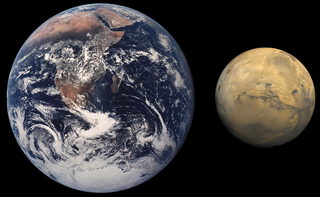How Big is Mars? | Size of Planet Mars
Mars, the fourth planet from the sun, is the second smallest planet in the solar system; only Mercury is smaller. Mars is about half (53 percent) the size of Earth, but because Mars is a desert planet, it has the same amount of dry land as Earth. The simple question of how big Mars is depends on what measurements you consider.

Diameter and circumference
Despite appearances, Mars is not a sphere. Because the planet rotates on its axis (every 24.6 hours), it bulges at the equator (as do Earth and other planets). At its equator, Mars has a diameter of 4,222 miles (6,794 km), but from pole to pole, the diameter is 4,196 miles (6,752 km). Mars’ radius is, of course, half of planet’s diameter.
The circumference of Mars around the equator is about 13,300 miles (21,343 km), but from pole-to-pole Mars is only 13,200 miles (21,244 km) around. This shape is called an oblate spheroid. [Video: Why Is Mars So Small?]
Mass and gravity
Mars' mass is 6.42 x 1023 kilograms, about 10 times less than Earth. This affects the force of gravity. Gravity on Mars is 38 percent of Earth's gravity, so a 100-pound person on Earth would weigh 38 pounds on Mars.
Highest mountain, deepest valley
Mars is home to both the highest mountain and the deepest, longest valley in the solar system. Olympus Mons is roughly 17 miles (27 kilometers) high, about three times as tall as Mount Everest. It is also one of the largest volcanoes in the solar system. It is about 370 miles (600 kilometers) in diameter, wide enough to cover the entire state of New Mexico.
The Valles Marineris system of valleys — named after the Mariner 9 probe that discovered it in 1971 — can go as deep as 6 miles (10 kilometers) and runs east-west for roughly 2,500 miles (4,000 kilometers), about one-fifth of the distance around Mars and close to the width of Australia or the distance from Philadelphia to San Diego.
— Tim Sharp, Reference Editor
Related:
Join our Space Forums to keep talking space on the latest missions, night sky and more! And if you have a news tip, correction or comment, let us know at: community@space.com.
Get the Space.com Newsletter
Breaking space news, the latest updates on rocket launches, skywatching events and more!

